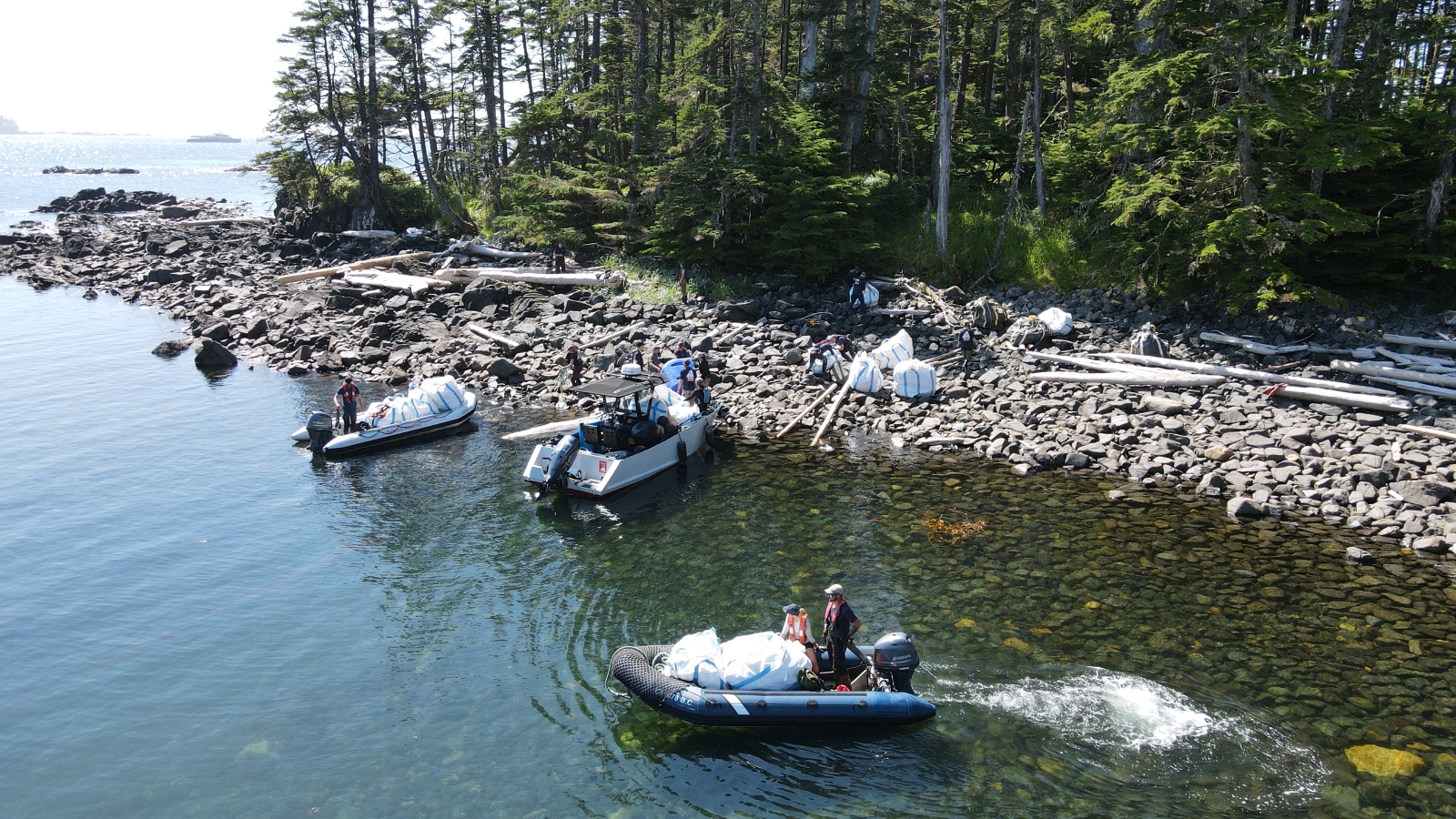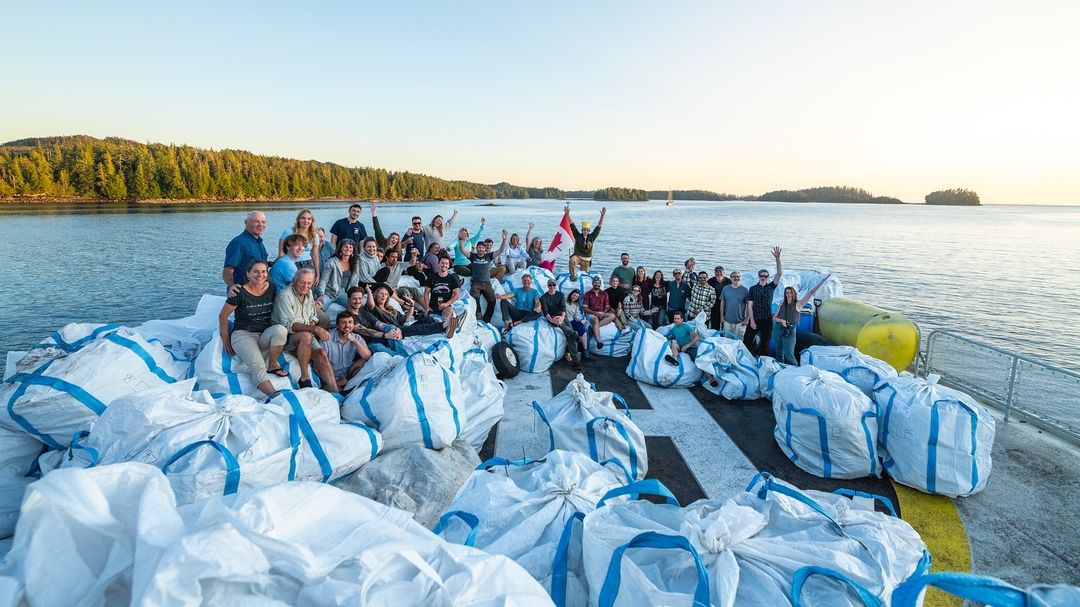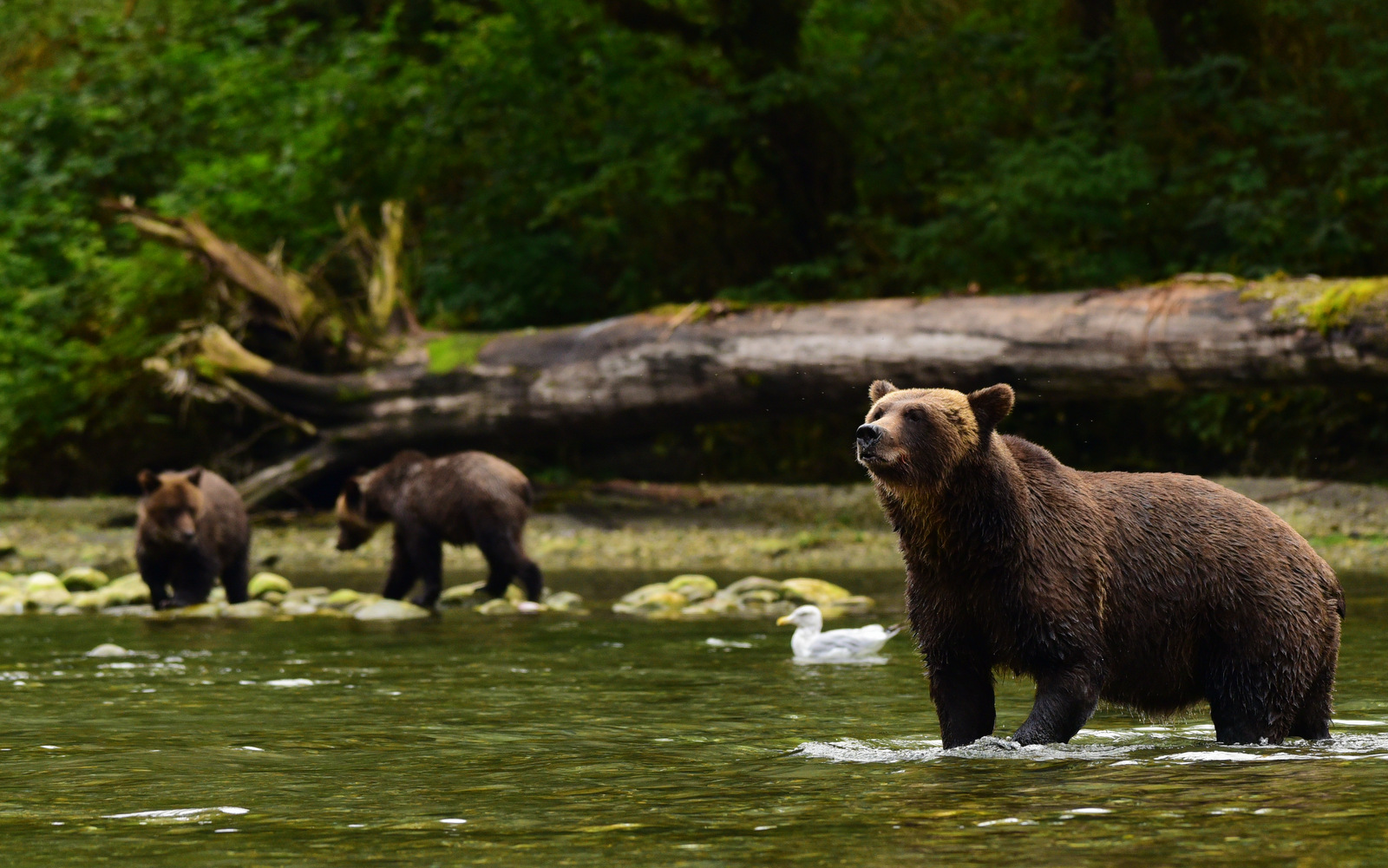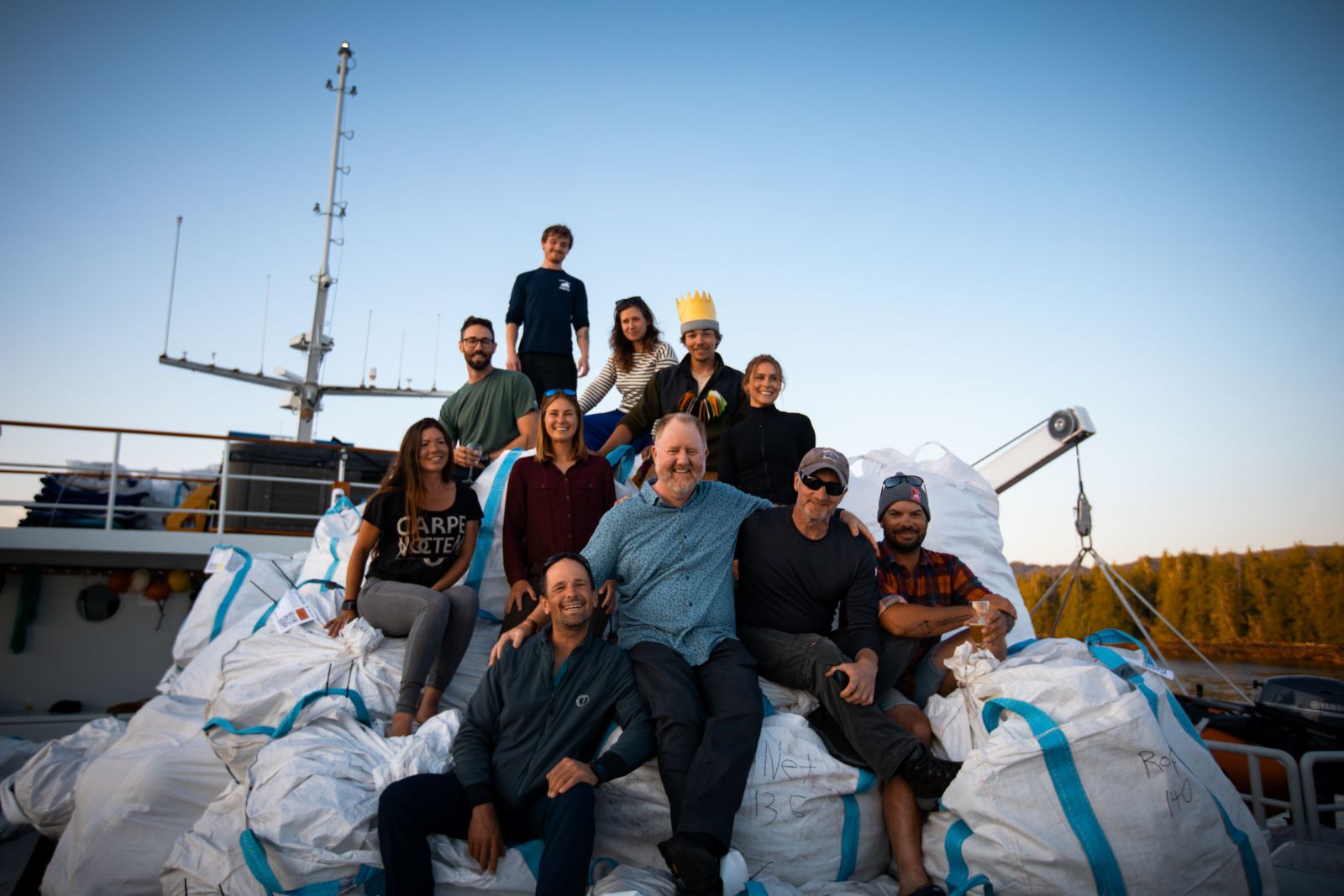Photo: Jeff Reynolds
This summer, our crew rolled up their sleeves to protect the coast they love and share with guests!
The Great Bear Rainforest is one of the most pristine and ecologically significant regions on Earth. Its remote and rugged shores may seem far removed from our bustling cities, but the debris that washes up here tells a different story.
For decades, marine debris has washed ashore on its exposed outer coastline, entangling wildlife, polluting habitats, and threatening the delicate balance of this unique ecosystem. Members of the Small Ship Tour Operators Association (SSTOA) have witnessed this slow-motion oil spill. When the pandemic halted tourism, seven operators seized an opportunity to turn the tide.

Photo: Kevin Smith
Our coastal clean ups take place more than 500 kilometres from the nearest big city, where the impact of marine debris often goes unseen.
Enter the first Marine Debris Removal Initiative (MDRI), an unprecedented effort to preserve the natural beauty and ecological integrity of British Columbia’s central and northern coast. These expeditions provided work for over 100 crew and guides, supported local economies, and highlighted the importance of addressing marine debris as part of global efforts.
When tourism resumed, the spirit of the MDRI endured, inspiring many of our wonderful guests to participate in voluntary beach cleanups during their trips to Haida Gwaii, Vancouver Island and the Great Bear Rainforest. But even then, we knew there was more work to be done…
This article delves into the latest chapter of the MDRI, the challenges faced, the successes achieved, and what lies ahead in our journey to heal one of the world’s last great wildernesses.
Setting Course for the Outer Islands of the Great Bear Rainforest
This summer, Maple Leaf Adventures, along with Bluewater Adventures and the Wilderness Tourism Association of BC, saw an opportunity for a smaller-scale expedition in the middle of their tourism season. With 48 crew aboard three ships—the flagship 92-foot schooner Maple Leaf, the 138-foot catamaran Cascadia, and Bluewater’s 68-foot ketch Island Roamer—they charted a course to tackle marine debris once again.
Significant risks were taken; time that would typically be dedicated to guest trips was set aside, all in the belief that the expedition would receive the necessary government funding. That funding arrived just a month before the ships were due to disembark, spurring our leaders into action at the final hour.
Our expedition targeted the outer islands and west-facing shorelines of Queen Charlotte Sound, areas particularly exposed to debris due to their position relative to the North Pacific Subtropical Gyre. These rugged, high-energy environments, characterised by steep headlands and low rocky zones, naturally trap debris, which either ends up high in the forest fringe or, commonly, is washed back to sea and redistributed along the coastline.
We targeted small coves, surge channels, bays, beaches, and bights—prime locations for beach-cast debris and accessible landing sites for our skiffs. Our ships would stagger their arrivals: Maple Leaf and Island Roamer would collect and stow debris in lift bags above the high-water mark, while Cascadia followed days later to ferry debris to her spacious sorting deck.
Inside the Mission: A Battle Against Time and Tide
What our crew encountered on the expedition was a coastline under siege: tangled fishing gear and nets choked the rocky shores, ropes lay pinned beneath stacks of driftwood, polystyrene floats buried deep in the mossy underbrush, and plastic bottles scattered as relentless reminders of our throwaway culture.
Each day, our crew collected tonnes of debris, hoisted by crane onto Cascadia’s helideck for sorting. Through our partnerships with Ocean Legacy, Kitimat Understanding the Environment (KUTE), and the Heiltsuk community, we ensured that as much as 80% was repurposed or recycled, giving new life to what was once waste.
For the full scoop, watch the captivating video that crew member and expedition data specialist Jeff Reynolds put together, below:
The Haul: What We Collected
In this latest phase of the MDRI, our crews collected a staggering 32.5 tonnes of debris. Among the haul were 11 tonnes of rope, 3.5 tonnes of netting, 19,000 plastic bottles, and much more.

Infographic: Jeff Reynolds
Every day, crew meticulously sorted through materials, separating out anything that could be diverted from landfills.
| Debris Type | Weight % | Volume % | kg |
|---|---|---|---|
| Rope | 37% | 16% | 11531 |
| Landfill | 20% | 24% | 6356 |
| Netting | 11% | 6% | 3435 |
| Reusable Hard Plastic Floats | 11% | 11% | 3339 |
| Hard Plastic Fragments | 9% | 11% | 1184 |
| Tires | 2% | 13% | 766 |
| Beverage Bottles | 2% | 9% | 548 |
| Plastic Barrels | 1% | 3% | 389 |
| Reusable Foam Floats | 1% | 2% | 341 |
| Oyster Baskets | 1% | 1% | 122 |
The marine debris we encountered is part of a global issue, carried across vast distances by the complex wind patterns and ocean currents that govern the planet’s oceans. Due to this oceanographic system, the outer coasts of British Columbia, including the Great Bear Rainforest, receive a slow but persistent delivery of marine debris from across the Pacific—with sources as far away as Indonesia, the Philippines, China, Taiwan, Korea, Japan, and Russia.
While much of the debris we encounter originates from distant shores, local sources contribute to the problem, too. The fishing industry, with its lost or abandoned nets, ropes, and gear, has left a lasting impact on the coastlines they depend on. The ZIM Kingston disaster in 2021 also exacerbated the problem. This cargo ship lost more than 100 containers off the coast of British Columbia during a storm, scattering plastic goods across 1000’s of kilometers of shoreline.
It Takes a Village: A Collaboration of Coastal Scale
The success of the latest cleanup effort was not just a result of hard work but of careful coordination and collaboration. We were proud to work alongside our colleagues at Bluewater Adventures, Frank Brown and the youth of the Heiltsuk Nation, the Gitga’at Nation, the Kitasoo Xai’Xais Nation, and businesses like Bridgeman’s, Ocean Legacy, and KUTE. The BC government’s Clean Coast, Clean Waters Fund provided essential funding, and the Wilderness Tourism Association played a crucial role in administering it all.

Photo: Jeff Reynolds
The Cascadia crew gather on the helideck to celebrate an encouraging step toward protecting their coastal home.
Together, we removed a staggering 32.5 tonnes of debris from the Great Bear Rainforest shoreline—a testament to what can be achieved when we come together with a shared purpose.
The True Cost of Marine Debris—and Why We Fight It
Marine debris is more than an eyesore—it’s a slow-motion disaster for wildlife and ecosystems. Discarded fishing gear can be linked to increased whale entanglements on the coast (50% of humpback whales on this coast have scars from entanglement), while plastic breaks down into harmful microplastics that infiltrate the food chain.

Photo: Phil Stone
The International Whaling Commission estimates that over 300,000 whales and dolphins die annually due to entanglement in fishing gear, with additional unknown numbers also entangled in marine debris.
By removing 32.5 tonnes of debris, we’re not just cleaning up—we’re preventing future harm to the whales, seabirds, and other wildlife that depend on these pristine environments. This work is essential to preserving the biodiversity of the Great Bear Rainforest and ensuring that future generations can experience its beauty as we get to today.
See for Yourself: Explore the Great Bear Rainforest as a Guest
There’s few better ways to understand the importance of this work than to experience the breathtaking beauty of the Great Bear Rainforest for yourself.

Photo: Greg Shea
While guests won’t be expected to clean debris (unless they want to!) they can enjoy the wonders of an ecosystem still separate from humanity.
While larger expedition ships are entering the region without local ties or consideration of their footprint, your journey with Maple Leaf Adventures supports a conservation-based economy with direct benefits to the coast.
Join us on a journey where every step we take is guided by a deep respect for nature and a commitment to regenerative tourism. Together, we are making real difference.
Learn More

